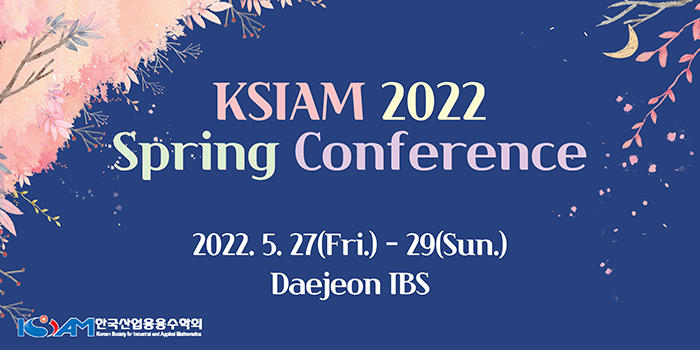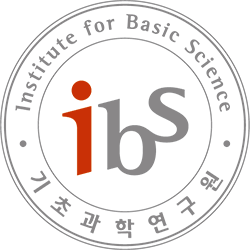
- This event has passed.
KSIAM 2022 Spring Meeting
Friday, May 27, 2022 @ 1:20 PM - 5:40 PM KST

KSIAM (Korean Society for Industrial and Applied Mathematics) will have the KSIAM 2022 Spring Conference at the Institute for Basic Science (IBS). Its academic session for Combinatorics decided to have an invited talk by Joonkyung Lee at the Hanyang University, a special session “Graph Theory” organized by Sang-il Oum and the IBS DIMAG, a special session “Enumerative Combinatorics” organized by Dongsu Kim at KAIST, and a poster session, all on May 27 afternoon. The deadline for the abstract submission is May 2 and the deadline for the early registration is May 9.
Invited talk (May 27 Friday, 16:40-17:40)
Joonkyung Lee이준경 (Hanyang University), Graph homomorphism inequalities and their applications
Counting (weighted) homomorphisms between graphs relates to a wide variety of areas, in- cluding graph theory, probability, statistical physics and theoretical computer science. In recent years, various new applications of inequalities between graph homomorphism counts have been found.
We will discuss some of the examples, including a simple proof of the Bondy–Simonovits theorem and a new estimate for the rainbow Turán numbers of even cycles. If time permits, we will also touch upon some recent progress on Sidorenko’s conjecture and related questions, in particular their applications on the bipartite Turán problems.
Based on joint work with David Conlon, Jaehoon Kim, Hong Liu, and Tuan Tran.
Special session “Graph Theory” (May 27, 13:20-14:40)
Organized by Sang-il Oum엄상일 (IBS Discrete Mathematics Group & KAIST).
Speakers
Boram Park박보람 (Ajou University), Odd Coloring of Graphs
An odd $c$-coloring of a graph is a proper $c$-coloring such that each non-isolated vertex has a color appearing an odd number of times on its neighborhood. Recently, Cranston investigated odd colorings of graphs with bounded maximum average degree, and conjectured that every graph $G$ with $\operatorname{mad}(G)\leq \frac{4c-4}{c+1}$ has an odd $c$-coloring for $c\geq 4$, and proved the conjecture for $c\in\{5, 6\}$. In particular, planar graphs with girth at least $7$ and $6$ have an odd $5$-coloring and an odd $6$-coloring, respectively.
We completely resolve Cranston’s conjecture. For $c\geq 7$, we show that the conjecture is true, in a stronger form that was implicitly suggested by Cranston, but for $c=4$, we construct counterexamples, which all contain $5$-cycles. On the other hand, we show that a graph $G$ with $\operatorname{mad}(G)<\frac{22}{9}$ and no induced $5$-cycles has an odd $4$-coloring. This implies that a planar graph with girth at least 11 has an odd $4$-coloring. We also prove that a planar graph with girth at least 5 has an odd $6$-coloring.
Joint work with Eun-Kyung Cho, Ilkyoo Choi, and Hyemin Kown.
Jongyook Park박종육 (Kyungpook National University), On the Delsarte bound
We study the order of a maximal clique in an amply regular graph with a fixed smallest eigenvalue by considering a vertex that is adjacent to some (but not all) vertices of the maximal clique. As a consequence, we show that if a strongly regular graph contains a Delsarte clique, then the parameter μ is either small or large. Furthermore, we obtain a cubic polynomial that assures that a maximal clique in an amply regular graph is either small or large (under certain assumptions). Combining this cubic polynomial with the claw-bound, we rule out an infinite family of feasible parameters (v, k, λ, μ) for strongly regular graphs. Lastly, we provide tables of parameters (v, k, λ, μ) for nonexistent strongly regular graphs with smallest eigenvalue −4,−5,−6 or −7. This is joint work with Gary Greaves and Jack Koolen.
O-joung Kwon권오정 (Hanyang University and IBS Discrete Mathematics Group), Well-partitioned chordal graphs
We introduce a new subclass of chordal graphs that generalizes the class of split graphs, which we call well-partitioned chordal graphs. A connected graph $G$ is a well-partitioned chordal graph if there exist a partition $\mathcal{P}$ of the vertex set of $G$ into cliques and a tree $\mathcal{T}$ having $\mathcal{P}$ as a vertex set such that for distinct $X,Y\in \mathcal{P}$, (1) the edges between $X$ and $Y$ in $G$ form a complete bipartite subgraph whose parts are some subsets of $X$ and $Y$, if $X$ and $Y$ are adjacent in $\mathcal{T}$, and (2) there are no edges between $X$ and $Y$ in $G$ otherwise. A split graph with vertex partition $(C, I)$ where $C$ is a clique and $I$ is an independent set is a well-partitioned chordal graph as witnessed by a star $\mathcal{T}$ having $C$ as the center and each vertex in $I$ as a leaf, viewed as a clique of size $1$. We characterize well-partitioned chordal graphs by forbidden induced subgraphs, and give a polynomial-time algorithm that given a graph, either finds an obstruction, or outputs a partition of its vertex set that asserts that the graph is well-partitioned chordal.
We observe that there are problems, for instance Densest $k$-Subgraph and $b$-Coloring, that are polynomial-time solvable on split graphs but become NP-hard on well-partitioned chordal graphs. On the other hand, we show that the Geodetic Set problem, known to be NP-hard on chordal graphs, can be solved in polynomial time on well-partitioned chordal graphs. We also answer two combinatorial questions on well-partitioned chordal graphs that are open on chordal graphs, namely that each well-partitioned chordal graph admits a polynomial-time constructible tree $3$-spanner, and that each ($2$-connected) well-partitioned chordal graph has a vertex that intersects all its longest paths (cycles). Joint work with Jungho Ahn, Lars Jaffke, and Paloma T. Lima.
Stijn Cambie (IBS Extremal Combinatorics and Probability Group), Regular Cereceda’s Conjecture
The reconfiguration graph $\mathcal C_k(G)$ for the $k$-colourings of a graph $G$ has a vertex for each proper $k$-colouring of $G$, and two vertices of $\mathcal C_k(G)$ are adjacent precisely when those $k$-colourings differ on a single vertex of $G$. Much work has focused on bounding the maximum value of $\operatorname{diam} \mathcal C_k(G)$ over all $n$-vertex graphs $G$. One of the most famous conjectures related related to $\mathcal C_k(G)$ is Cereceda’s conjecture, which says that if $k \ge \operatorname{degen}(G) + 2$, the diameter of $\mathcal C_k(G)$ is $O(n^2)$. In this talk, we give some ideas towards a precise form for Cereceda’s conjecture, when restricting to regular graphs.
This is based on joint work with Wouter Cames van Batenburg (TU Delft, the Netherlands) and Daniel Cranston (Virginia Commonwealth University, USA), which originates from the online workshop Graph Reconfiguration of the Sparse Graphs Coalition.
Special session “Enumerative Combinatorics” (May 27, 15:00-16:20)
Organized by Dongsu Kim김동수 (KAIST).
Speakers
Meesue Yoo류미수 (Chungbuk National University), Combinatorial description for the Hall-Littlewood expansion of unicellular LLT and chromatic quasisymmetric polynomials
In this work, we obtain a Hall–Littlewood expansion of the chromatic quasisymmetric functions by using a Dyck path model and linked rook placements. By using the Carlsson–Mellit relation between the chromatic quasisymmetric functions and the unicellular LLT polynomials, this combinatorial description for the Hall–Littlewood coefficients of the chromatic quasisymmetric functions also gives the coefficients of the unicellular LLT polynomials expanded in terms of the modified transformed Hall–Littlewood polynomials. Joint work with Seung Jin Lee.
Donghyun Kim김동현 (Sungkyunkwan University), Combinatorial formulas for the coefficients of the Al-Salam-Chihara polynomials
The Al-Salam-Chihara polynomials are an important family of orthogonal polynomials in one variable $x$ depending on 3 parameters $\alpha$, $\beta$ and $q$. They are closely connected to a model from statistical mechanics called the partially asymmetric simple exclusion process (PASEP) and they can be obtained as a specialization of the Askey-Wilson polynomials. We give two different combinatorial formulas for the coefficients of the (transformed) Al-Salam-Chihara polynomials. Our formulas make manifest the fact that the coefficients are polynomials in $\alpha$, $\beta$ and $q$ with positive coefficients.
Jisun Huh허지선 (Ajou University), Combinatorics on bounded Motzkin paths and its applications
A free Motzkin path of length \(n\) is a lattice path which starts at \((0,0)\) or \((0,1)\), ends at \((n,0)\), and has only up steps \(u=(1,1)\), down steps \(d=(1,-1)\), and flat steps \(f=(1,0)\). In addition, if a free Motzkin path starts at \((0,0)\) and stays weakly above the \(x\)-axis, then it is called a Motzkin path. In this talk, we construct a bijection between \(F(m,r,k)\) and \(M(m,r,k)\), where \(F(m,r,k)\) is the set of free Motzkin paths of length \(m+r\) with \(r\) flat steps that are contained in the strip \(-\lfloor k/2 \rfloor \leq y \leq \lfloor (k+1)/2 \rfloor\) and \(M(m,r,k)\) is the set of Motzkin prefixed of length \(m+r\) with \(r\) flat steps that are contained in the strip \(0 \leq y \leq k\). Furthermore, we provide path interpretations of ordinary/self-conjugate \(t\)-core partitions with \(m\)-corners as an application.
This is joint work with Hyunsoo Cho, Hayan Nam, and Jaebum Sohn.
Jihyeug Jang장지혁 (Sungkyunkwan University), A combinatorial model for the transition matrix between the Specht and web bases
We introduce a new class of permutations, called web permutations. Using these permutations, we provide a combinatorial interpretation for entries of the transition between the Specht and web bases, which answers Rhoades’s question. Furthermore, we study enumerative properties of these permutations. Joint work with Byung-Hak Hwang and Jaeseong Oh.

